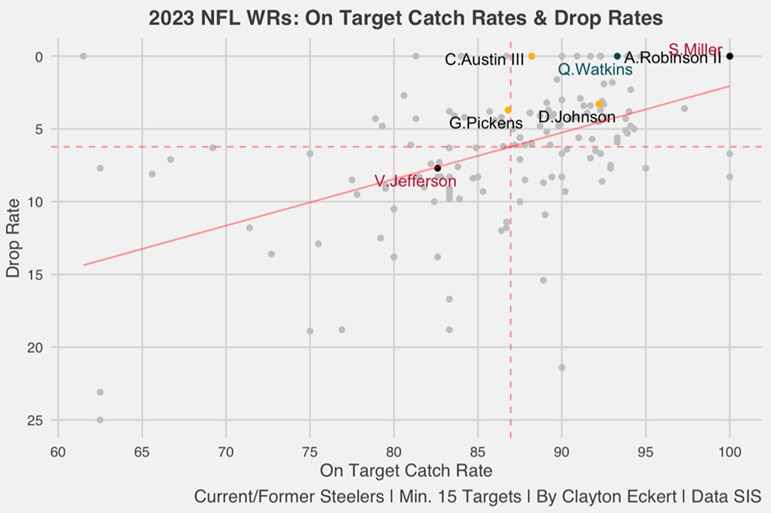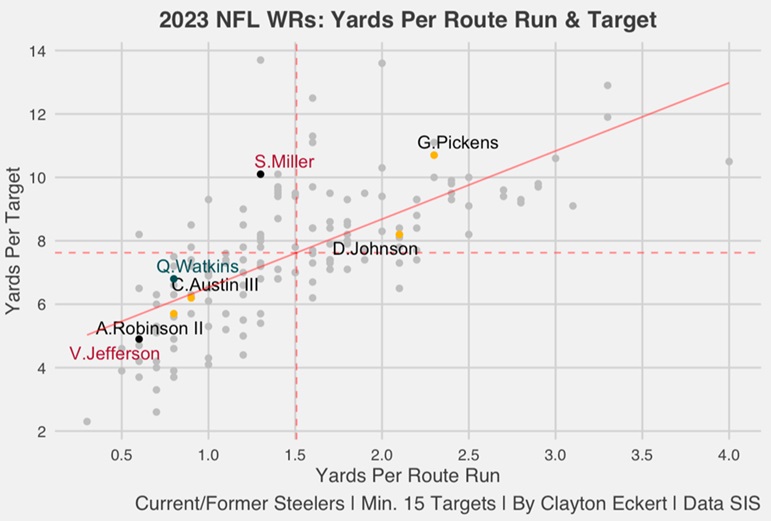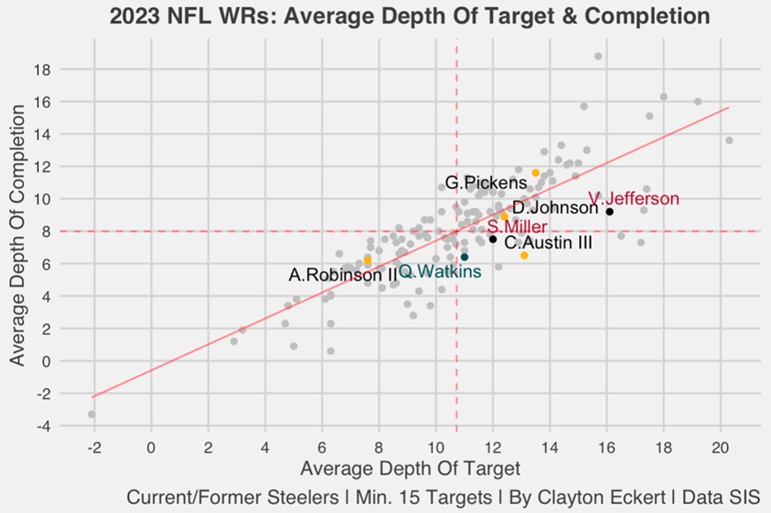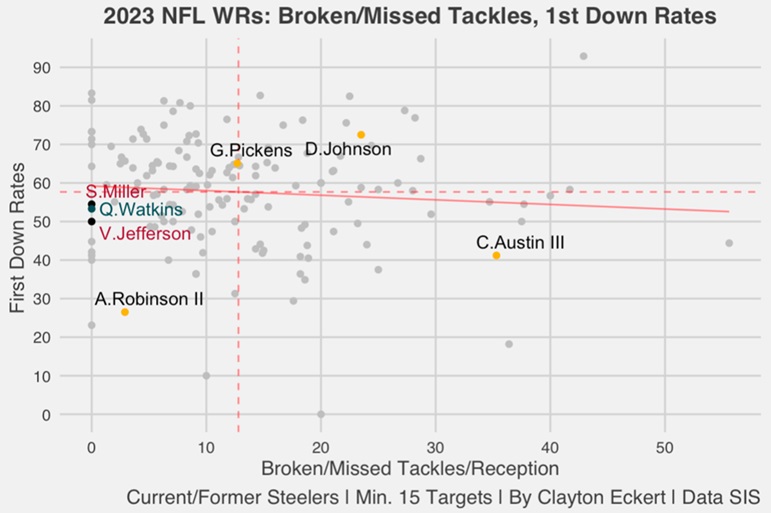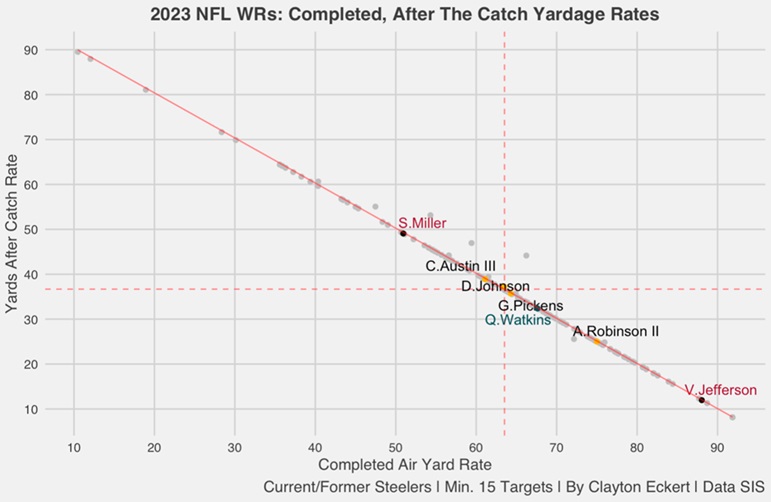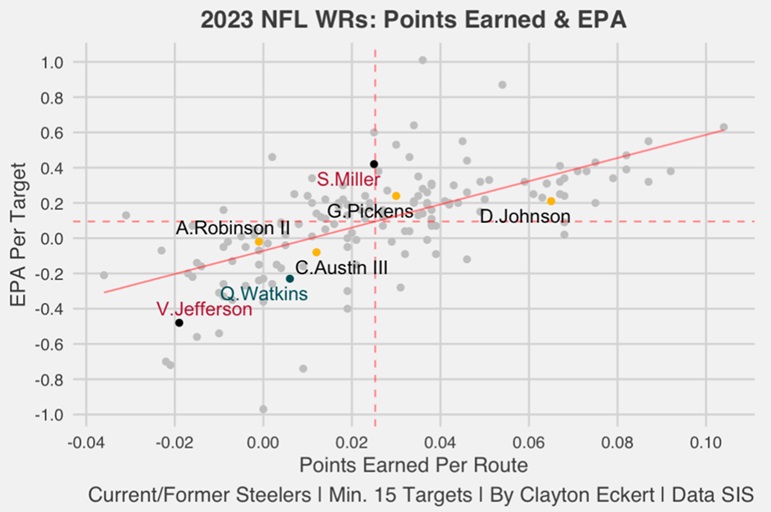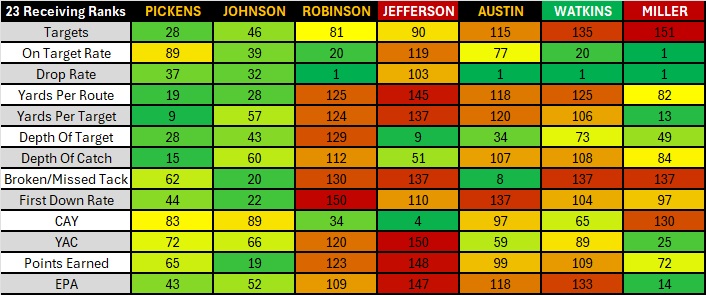Today I wanted to continue the series, studying NFL position groups and facets of the game. Next up are wide receivers, looking at receiving data from Sports Info Solutions (SIS).
The stats in this study are from the 2023 season, focusing on current and former Pittsburgh Steelers. The goal is to see how they stacked up against their NFL peers.
Let’s dive in, starting with on-target catch percentage (total receptions/number of catchable targets). This highlights the quality of targets and connectivity along with drop percentage (drops/catchable targets) to see who made the most of their expected-catch situations:
Encouragingly, the majority of focused players land toward the top right. New addition Scotty Miller had perfect marks, with a 100 percent on target catch rate along with zero-percent drop rate.
It is important to note the 15-target minimum for this study (153 qualifiers) in order to examine the group we’re focused on, with less targets obviously making that feat more attainable. Here are the targets of highlighted players in 2023:
George Pickens: 107 (28th)
Diontae Johnson: 87 (46th)
Allen Robinson II: 49 (T-81st)
Van Jefferson: 43 (90th)
Calvin Austin III: 29 (T-115th)
Quez Watkins: 21 (T-135th)
Scotty Miller: 16 (T-151st)
Pickens was the only player to top 100, which seems likely to occur again in 2024 with Johnson and Robinson no longer with the team. The rest of the group ranked 90th or lower in targets, and how that will transpire this season is a big question mark. We also see Miller tying for the third-fewest targets (16), adding very important context to his rank.
Fewer targets also thankfully equated to perfect drop rates. Like Miller, this also included Robinson, the new Steeler in Watkins, and Austin. Robinson and Watkins had the stronger 93.3 on target catch rate (T-20th), compared to Austin’s slightly above the mean 88.2-percent (T-77th).
The unfortunate exception to fewer targets equaling strong catch rates in 2023 was Jefferson. An 82.6 on target catch rate and 7.7 drop rate tied for 119th and 103rd. Not a strong recent resume in these terms for a player many think could take on a WR2 role for Pittsburgh this season.
Those opportunities were vacated with the offseason trade of Johnson, who had double the targets and landed above the mean in each rate despite this. Johnson’s 92.2 on target-catch rate and 3.3 drop rate tied for 39th and 32nd respectively and are two elements to consider in his vacated snaps for 2024.
Pickens had a near-the-mean 86.8 on target-catch rate (89th), and an above-average 3.7 drop rate (T-37th). He no doubt makes insane catches that few can, and while his drop rate is encouraging, I am looking for an improved on-target catch rate as he aims for stardom.
Next let’s look at yards per route run (YPRR=total receiving yards/number of routes run excluding RPO handoffs) and yards per target (YPT=receiving yards per pass attempt in which the receiver is targeted, including incompletions) to get an idea of how the wide receivers were utilized:
My big initial takeaway is Pickens and Johnson being the only two focused players above the mean in the yardage data. Pickens was comfortably above it in each, with 2.3 YPRR (T-19th) and 10.7 YPT that slotted even more favorably at ninth. It will be interesting to see what his 2024 numbers pan out to be, and if an expanded route tree, as expected, perhaps lowers those totals.
Johnson had 2.1 YPRR (T-28th) last year, but an 8.2 YPT that tied for a notably lower 57th, meaning he was targeted shorter than his heathier depth of routes overall. This is an example of the possible impact for Pickens in 2024, which will be fascinating to see unfold.
The only other above-the-mean result was posted by Miller. His 10.1 YPT tied for 13th among his peers despite a much lower 1.3 YPRR that tied for 82nd. His opportunities were low but his utilization very telling. Hopefully, he can add a similar element to Pittsburgh’s offense in 2024.
The rest of the group lands on the bottom left, and here are the results:
Watkins: 0.8 YPRR (T-125th), 6.8 YPT (T-106th).
Austin: 0.9 YPRR (T-118th), 6.2 YPT (T-120th).
Robinson: 0.8 YPRR (T-125th), 5.7 YPT (T-124th).
Jefferson: 0.6 YPRR (T-145th), 4.9 YPT (T-137th).
The name of the game for this group was short targets overall with guys like Watkins and Austin having a deeper element than Robinson and Jefferson comparatively. If things transpire similarly, Pittsburgh’s revamped receiver position could seemingly add more yardage than last season. At least on paper.
Let’s further examine wide receiver usage with average depth of target (ADOT=average distance downfield that the targeted throws traveled, excluding spikes and throwaways) and average depth of completion (ADOC) to zero in on opportunities more in the receiver’s control:
Interesting info to layer with the previous view. Jefferson joins Pickens and Johnson as the above-the-mean focused players. The former led the group with a 16.1 ADOT that ranked ninth, but a 9.2 ADOC fell considerably (T-51st).
Pickens had the strongest 11.6 ADOC (T-15th), not far from his 13.5 ADOT (T-28th), an encouragingly nice split in comparison. Johnson’s 12.4 ADOT (T-43rd) was his better mark, compared to an 8.9 ADOC (T-60th).
Miller and Austin also had above-average depths of target, but completions were slightly below. The former posted a 12.0 ADOT (T-49th) and 7.5 ADOC (T-84th), while Austin had 13.1 ADOT (T-34th) and 6.5 ADOC (107th), an even bigger spread.
Both caught mostly shorter targets, which is true to an extent for any receiver, but the trendline (diagonal line) on the visual highlights it being the case for every new Steeler.
Watkins had a slightly above-average 11.0 ADOT (T-73rd), and 6.4 ADOC (T-108th). Robinson had the lowest results of focused players, with 7.6 ADOT (T-129th) and 6.2 ADOC (112th). This is an example of healthier completion numbers that players in our sights lacked overall, with Robinson and Pickens at a greater depth of target the only ones to do so.
Continuing with more important factors, here are the wide receivers’ first-down percentages (percentage of receptions where the receiver achieved a first down) along with broken/missed tackles per reception, a fun and telling data point. The goal here is to see who provided moving-the-chains plays and which players also showed the ability to make guys miss:
The three additions Pittsburgh made this offseason land on the extreme left of the chart, meaning they had zero broken/missed tackles in 2023, which was unfortunate to learn. This would be painful if it reoccurred this season and would likely hinder YAC, which the Steelers improved on last season (more on this to come).
In turn, that group was also below the mean in first down rates: Miller 54.5 (T-97th), Watkins 53.3 (T-104th), Jefferson 50.0 (T-110th). Robinson also landed in that quadrant with a minimal 2.9 broken/missed tackle rate (T-130th) and a surprisingly stark 26.5 first-down rate (150th) that was fourth worst among qualifiers. Hopefully the new group provides that comparatively stronger first-down element for the Black and Gold.
Austin had the second-lowest 41.2 first down rate of focused players (T-137th) despite an impressive 35.3 broken/missed tackle rate that was eighth best last year. The latter is encouraging, but the numbers emphasize a lack of situational value that’s hopefully more positive in 2024.
Johnson was the only highlighted player comfortably above the mean in each: 23.5 broken/missed tackle rate (T-20th), 72.5 first-down percentage (22nd), strong contributions that need replaced. Pickens had the only other above average 65.1 first-down percentage (44th), while landing at it with 12.7 broken/missed tackles (T-62nd).
Here are wide receivers’ completed air-yard percentage (CAY) along with yards after catch rate (YAC) to see context of how the receivers’ yards came:
New Steelers lead each data point. Miller was that man in terms of YAC (49.07), which ranked 25th. Jefferson had a whopping 88.04 CAY, ranking fourth-most. You can definitely see their contributions for Atlanta last season, and possibly what to anticipate in 2024.
Here are the full numbers:
Miller: 49.07 YAC (25th), 50.93 CAY (130th).
Austin: 38.89 YAC (59th), 38.89 CAY (97th).
Johnson: 37.24 YAC (66th), 63.46 CAY (89th).
Pickens: 35.7 YAC (72nd), 64.3 CAY (83rd).
Watkins: 32.39 YAC (89th), 67.61 CAY (65th).
Robinson: 25.0 YAC (120th), 75.0 CAY (34th).
Jefferson: 11.96 YAC (150th), 88.04 CAY (fourth).
I also wanted to provide a total value view using points earned per route (the total of a player’s EPA responsibility on routes run using the total points system that distributes credit among all players on the field for a given play). Totals are scaled up to map to the average points scored or allowed on a team level with the player’s snap count determining how much to adjust.
For receivers, this includes accounting for offensive line play, off-target passes, dropped passes, and broken tackles. Values are modulated using a quality-of-competition multiplier based on each opponent’s previous year of performance) and EPA per target (the total change in the offense’s expected points that came on passes thrown to the player):
Above the mean in each were Johnson and Pickens, again. The former had the strongest points earned per route, ranking 19th among his peers, and was slightly above average in EPA (T-52nd). Pickens’ points earned tied for 65th and was the strongest Steeler last year in EPA (T-43rd).
The only other above the mean result was Miller’s EPA, providing two TDs on minimal snaps and ranking 14th. With WR roles up for grabs, that would help his cause if he can connect with Pittsburgh QBs a similar way.
To close, here is a table of all the ranks:
Thanks for reading and let me know your thoughts in the comments.


